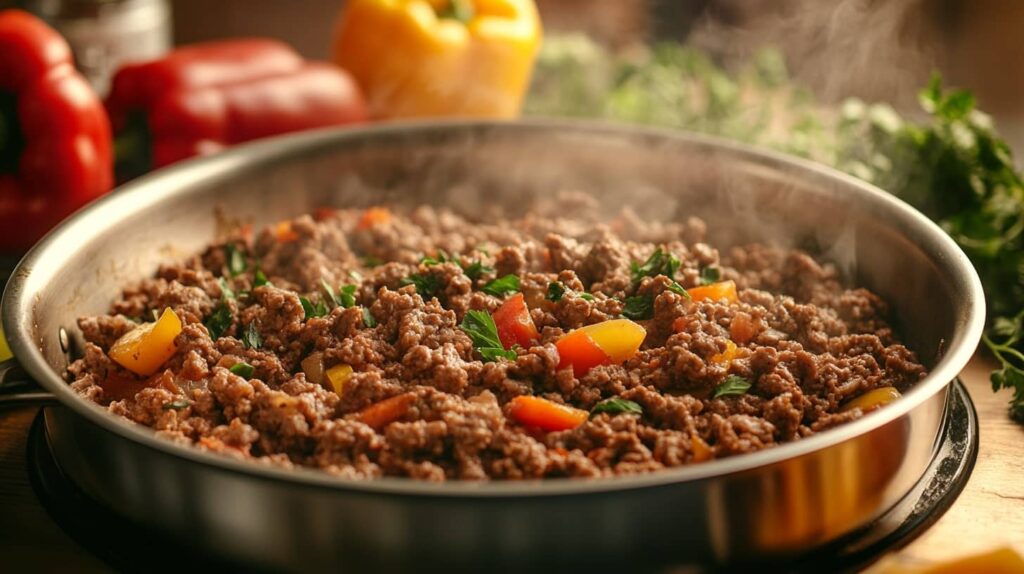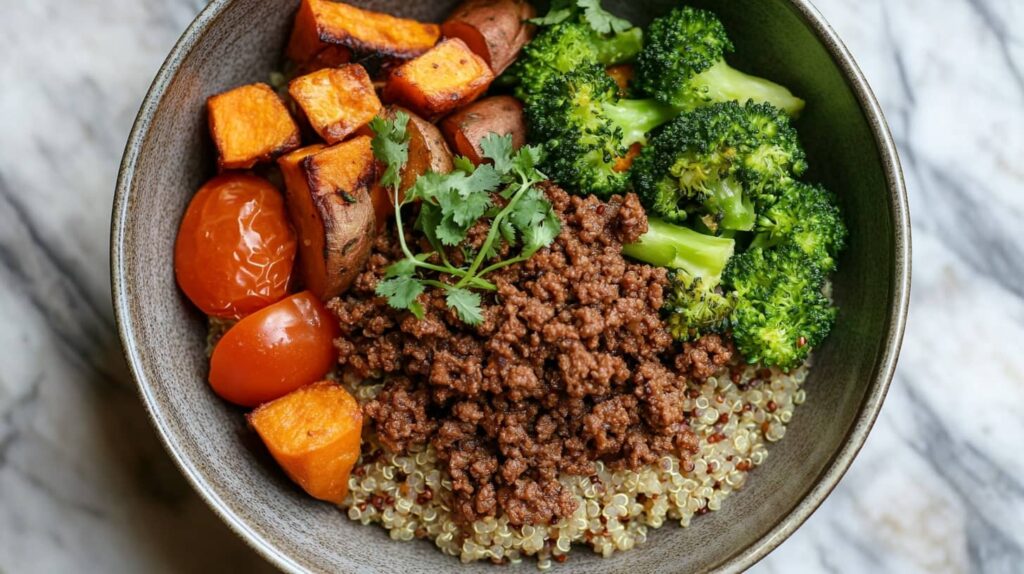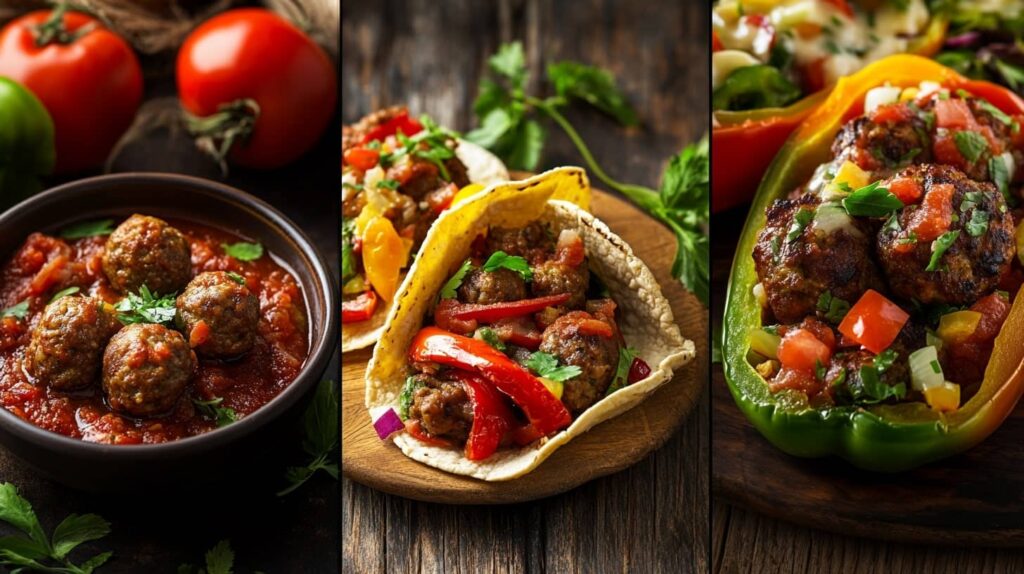
Minced beef nutrition is a crucial consideration for health-conscious food lovers. This versatile protein source, also known as ground beef, is a staple in kitchens around the world. Whether you’re focused on muscle building or balanced nutrition, understanding minced beef nutrition can help you make informed dietary choices. Let’s dive into this juicy topic of minced beef nutrition!
Imagine walking into your kitchen, the smell of sizzling minced beef wafting through the air. You can almost taste the deliciousness as you prepare your favorite meal. But wait! Before you dig in, it’s essential to understand what you’re putting on your plate.
Table of Contents
What is Minced Beef?
Minced beef, also known as ground beef, is simply beef that has been finely chopped. The minced beef nutrition profile varies depending on the cut used. It can come from various cuts of beef, including chuck, sirloin, or round. Understanding the nuances of ground beef nutrition helps you choose the most nutritionally beneficial option for your meals, allowing you to make the most of its benefits.
Why Choose Minced Beef?
- Versatility: You can use minced beef in a variety of dishes, from tacos and meatballs to chili and more! This versatility makes it easy to incorporate minced beef nutrition into your daily meals.
- Quick Cooking: It cooks faster than whole cuts of meat, making it perfect for busy weeknights when you want a nutritious meal quickly.
- Affordable: Generally, minced beef is more budget-friendly compared to other cuts of meat, making it a cost-effective way to get good ground beef nutrition.
Nutritional Profile of Minced Beef

Let’s delve into the minced beef nutrition profile. Understanding the nutritional composition of minced beef can help you make informed choices about your meals. Here’s a quick look at the nutrition facts per 100 grams of cooked minced beef:
| Nutrient | Amount per 100g |
|---|---|
| Calories | 250 |
| Protein | 26g |
| Total Fat | 17g |
| Saturated Fat | 7g |
| Cholesterol | 90mg |
| Sodium | 75mg |
| Iron | 2.7mg |
| Vitamin B12 | 2.4µg |
Macronutrients in Minced Beef
Protein Content and Benefits
One of the standout features of minced beef is its high protein content, a key aspect of minced beef nutrition. Protein is essential for building and repairing tissues, making it crucial for growing teens and active individuals.
“Protein is like the building blocks of your body. Without it, you wouldn’t have the muscles you need to run, jump, or even think!”
Eating a serving of minced beef can give you a significant boost of protein, a valuable component of ground beef nutrition, helping you feel full and satisfied. This can be particularly helpful if you’re trying to manage your weight or build muscle.
Fat Content: Good vs. Bad Fats
Now, let’s talk about fat and how it relates to minced beef nutrition. While some fat is necessary for energy and nutrient absorption, too much saturated fat can raise cholesterol levels and increase the risk of heart disease.
- Saturated Fat: Found in higher amounts in fattier cuts of beef, it’s best to consume in moderation.
- Unsaturated Fat: This is the healthier type of fat found in leaner cuts and can help improve heart health.
Micronutrients in Minced Beef
Minced beef isn’t just about protein and fat; it’s also packed with vitamins and minerals. Let’s take a closer look:
Vitamins Present in Minced Beef
Minced beef is a great source of Vitamin B12, which is crucial for red blood cell formation and brain health. It also contains other B vitamins like niacin and riboflavin, which help convert food into energy.
Minerals and Their Importance
Iron is another essential nutrient found in minced beef. It’s vital for transporting oxygen in the blood. If you’re feeling tired or sluggish, it might be due to a lack of iron in your diet.
“Think of iron as the fuel for your body’s engine. Without it, you can’t run smoothly!”
Additionally, minced beef contains zinc, which supports your immune system and helps wounds heal.
Health Benefits of Including Minced Beef

Muscle Building and Repair
The minced beef nutrition profile makes it an excellent choice for active individuals. If you’re involved in sports, incorporating ground beef nutrition into your diet can aid in muscle building and repair. The protein found in minced beef provides the necessary amino acids your body needs to recover after workouts.
Energy Production
Feeling sluggish? The nutrients in minced beef can help! The B vitamins and iron work together to provide energy, keeping you energized throughout the day.
Satiety and Weight Management
Eating meals that include minced beef can help you feel full longer. The protein and fat content can curb your hunger, reducing the likelihood of snacking on unhealthy foods later.
Common Concerns About Minced Beef
While minced beef nutrition offers many benefits, it’s important to understand how ground beef nutrition relates to these common concerns. Let’s address them.
Fat Content and Heart Health
As mentioned earlier, the fat content in minced beef can be a concern. Choosing leaner cuts can help reduce saturated fat intake while still providing the benefits of protein and other nutrients.
Risk of Contaminants in Ground Beef
Ground beef can sometimes be contaminated with harmful bacteria like E. coli or Salmonella. To minimize this risk, always cook minced beef thoroughly and practice safe food handling.
“Think of food safety as wearing a seatbelt. It’s a simple step that can save you from a lot of trouble!”
Environmental Impact of Beef Production
Beef production has a significant environmental footprint. If you’re concerned about sustainability, consider seeking out grass-fed or locally sourced options.
Solutions to Common Problems
Choosing Lean Cuts
When shopping for minced beef, look for labels that say “lean” or “extra lean.” This way, you can enjoy the benefits without the extra fat.
Safe Handling and Cooking Practices
Always wash your hands before and after handling raw meat. Cook minced beef to an internal temperature of 160°F (71°C) to ensure it’s safe to eat.
Sustainable Beef Options
Consider exploring sustainable beef options, such as grass-fed or organic minced beef. These choices can offer a healthier alternative for both you and the environment.
Common Concerns About Minced Beef
While minced beef offers numerous benefits, it’s important to address some common concerns. Understanding these issues can help you make informed choices about your diet.
Fat Content and Heart Health
One of the most frequently discussed topics regarding minced beef is its fat content. Many people worry about saturated fat and its link to heart disease.
- Saturated Fat: This type of fat is found in higher amounts in fatty cuts of beef. Consuming too much saturated fat can raise cholesterol levels, leading to an increased risk of heart disease. However, not all fats are bad. Your body needs some fat for energy and to absorb certain vitamins.
“Think of fats like the oil in a car engine. You need some to keep things running smoothly, but too much can cause problems!”
To enjoy minced beef while managing fat intake, opt for leaner cuts. Look for labels that specify “lean” or “extra lean.” These options typically contain less saturated fat while still providing essential nutrients.
Risk of Contaminants in Ground Beef
Another concern with minced beef is the risk of contamination. Ground beef can sometimes harbor harmful bacteria, such as E. coli and Salmonella. These bacteria can lead to foodborne illnesses if the meat isn’t cooked properly.
Tips for Safe Handling and Cooking
- Cook Thoroughly: Always cook minced beef to an internal temperature of 160°F (71°C). This ensures that any harmful bacteria are killed.
- Avoid Cross-Contamination: Use separate cutting boards for raw meat and other foods. Wash your hands, utensils, and surfaces thoroughly after handling raw meat.
- Store Properly: Keep minced beef refrigerated and use it within one to two days of purchase. If you’re not using it right away, freeze it to maintain freshness.
“Think of food safety as a shield protecting you from illness. A little care can go a long way!”
Environmental Impact of Beef Production
Beef production has a significant environmental footprint, from greenhouse gas emissions to water usage. If you’re environmentally conscious, you might be concerned about the impact of your food choices.
Sustainable Beef Options
Fortunately, there are ways to enjoy minced beef while being mindful of the environment. Here are some tips:
- Choose Grass-Fed Beef: Grass-fed beef is often raised on pasture, which can be more sustainable than grain-fed options. It typically has a lower environmental impact.
- Support Local Farmers: Buying from local farms can reduce transportation emissions and support sustainable farming practices.
- Incorporate Meatless Meals: Consider having meatless days in your week. This not only benefits the environment but can also be a fun way to explore new recipes!
Solutions to Common Problems
Now that we’ve discussed some concerns, let’s explore solutions to ensure you can enjoy minced beef safely and sustainably.
Choosing Lean Cuts
When shopping for minced beef, look for cuts labeled as “lean” or “extra lean.” These options have less fat, making them a healthier choice from a nutritional standpoint. Here’s a quick guide:
| Cut of Beef | Fat Content |
|---|---|
| Chuck | Higher fat |
| Round | Leaner |
| Sirloin | Lean |
| Brisket | Higher fat |
| Flank | Lean |
By selecting lean cuts, you can reduce your saturated fat intake while still enjoying the delicious taste of minced beef.
Safe Handling and Cooking Practices
To ensure your minced beef is safe to eat, follow these simple guidelines:
- Wash Hands: Always wash your hands before and after handling raw meat to prevent cross-contamination.
- Use a Food Thermometer: Invest in a food thermometer to ensure your minced beef is cooked to the proper temperature.
- Store Properly: Keep minced beef in the refrigerator and use it within one to two days. If you’re not cooking it right away, freeze it for later use.
“Think of these practices as your safety net. They help you enjoy delicious meals without worry!”
Sustainable Beef Options
If you’re concerned about the environment, consider choosing sustainable beef options. Here are some suggestions:
- Look for Certifications: Seek out beef that is certified organic or grass-fed. These labels often indicate more sustainable farming practices.
- Buy Local: Supporting local farmers can reduce transportation emissions and contribute to your community’s economy.
- Experiment with Alternatives: Try incorporating plant-based proteins into your diet, such as beans, lentils, or tofu. This not only reduces your meat consumption but also introduces new flavors and textures to your meals.
Creative Ways to Enjoy Minced Beef

Now that we’ve covered the key aspects of minced beef nutrition, let’s explore some delicious and nutritious ways to incorporate ground beef nutrition into your meals. Each recipe is designed to maximize the nutritional benefits of minced beef. The versatility of minced beef means you can whip up a variety of dishes that are not only tasty but also packed with nutrients!
1. Classic Spaghetti Bolognese
This Italian favorite is a fantastic way to enjoy minced beef. The rich flavors of the sauce combined with pasta make for a comforting meal.
Ingredients:
- 500g minced beef
- 1 onion, chopped
- 2 garlic cloves, minced
- 400g can of diced tomatoes
- 2 tablespoons tomato paste
- 1 teaspoon dried oregano
- Salt and pepper to taste
- Spaghetti pasta
Instructions:
- In a large skillet, sauté the onion and garlic until soft.
- Add the minced beef and cook until browned.
- Stir in the diced tomatoes, tomato paste, oregano, salt, and pepper. Simmer for 20 minutes.
- Serve over cooked spaghetti. Enjoy! 🍝
“This dish is like a warm hug on a plate. It’s comforting, filling, and perfect for family dinners!”
2. Tasty Tacos
Tacos are a fun and interactive meal that everyone can customize to their liking. Plus, they’re quick to prepare!
Ingredients:
- 500g minced beef
- 1 packet taco seasoning
- Taco shells
- Lettuce, diced tomatoes, shredded cheese, and sour cream for toppings
Instructions:
- Brown the minced beef in a skillet.
- Add taco seasoning and follow package instructions.
- Fill taco shells with the beef mixture and top with your favorite toppings.
“Tacos are like a party in your mouth! Each bite is a burst of flavor, and you can make them just how you like.” 🌮
3. Hearty Meatballs
Meatballs are great for pasta dishes, subs, or even as appetizers. They’re easy to make and can be frozen for later use.
Ingredients:
- 500g minced beef
- 1 cup breadcrumbs
- 1 egg
- 1/4 cup grated Parmesan cheese
- 2 tablespoons chopped parsley
- Salt and pepper to taste
Instructions:
- Preheat the oven to 200°C (400°F).
- In a bowl, mix all ingredients until well combined.
- Form into balls and place on a baking sheet.
- Bake for 20-25 minutes until cooked through.
“These meatballs are like little flavor bombs! Perfect for dipping or adding to your favorite sauce.”
4. Minced Beef Stir-Fry
For a quick and healthy dinner, try a minced beef stir-fry. It’s a fantastic way to include lots of veggies in your meal.
Ingredients:
- 500g minced beef
- 2 cups mixed vegetables (bell peppers, broccoli, carrots)
- 2 tablespoons soy sauce
- 1 tablespoon olive oil
- Cooked rice or noodles
Instructions:
- Heat olive oil in a pan and add the minced beef. Cook until browned.
- Add mixed vegetables and stir-fry for about 5-7 minutes.
- Stir in soy sauce and serve over rice or noodles.
“This stir-fry is like a rainbow on your plate! It’s colorful, nutritious, and super quick to make.” 🌈
5. Stuffed Peppers
Stuffed peppers are a delicious way to enjoy minced beef, and they look beautiful on the plate!
Ingredients:
- 4 bell peppers
- 500g minced beef
- 1 cup cooked rice
- 1 can diced tomatoes
- 1 teaspoon Italian seasoning
- Cheese for topping
Instructions:
- Preheat the oven to 180°C (350°F).
- Cut the tops off the bell peppers and remove the seeds.
- In a bowl, mix minced beef, rice, diced tomatoes, and seasoning.
- Stuff the mixture into the peppers and place them in a baking dish.
- Top with cheese and bake for 30-35 minutes.
“Stuffed peppers are like little edible bowls of goodness! Each bite is a delightful mix of flavors.”
Tips for a Balanced Diet
While minced beef nutrition can be a valuable part of your diet, it’s essential to understand how ground beef nutrition works alongside other food groups. Here are some tips:
1. Incorporate Plenty of Vegetables
Aim to fill half your plate with vegetables. They provide essential vitamins, minerals, and fiber. Try adding a side salad or steamed veggies to your minced beef dishes.
2. Choose Whole Grains
When serving minced beef with grains, opt for whole grains like brown rice or whole wheat pasta. They offer more nutrients and fiber than their refined counterparts.
3. Stay Hydrated
Don’t forget to drink plenty of water! Staying hydrated is crucial for overall health and helps your body function at its best.
Ready for More Culinary Adventures?
We’ve explored the ins and outs of minced beef nutrition, and hopefully, you’re feeling inspired to get cooking! But the journey doesn’t have to end here. If you’re eager to discover more delicious recipes and helpful tips, we’ve got you covered.
Perhaps you’re looking for ways to incorporate more lean protein into your diet? Check out our guide on “High-Protein Meal Ideas for Busy Weekdays”. Or maybe you’re keen to explore different cooking methods? Our article on “Mastering the Art of Healthy Stir-Fries” will be right up your alley.
And if you’re in the mood for something comforting, you won’t want to miss our “Ultimate Guide to Homemade Meatballs”, where we share all our secrets for perfect, juicy meatballs every time. Finally, for those seeking to balance out their meat intake with more plant-based options, our article on “Easy and Delicious Vegetarian Swaps” offers great ideas.
There’s a whole world of culinary delights waiting for you, so go ahead and explore!
Conclusion: Making Informed Choices
So, is minced beef nutrition right for you? The answer is yes, as long as you enjoy it mindfully and in moderation. With its rich flavor and nutritional benefits, minced beef can be a delicious part of a balanced diet.
By understanding its nutritional profile, addressing common concerns, and exploring creative recipes, you can enjoy minced beef while supporting your health. Remember to choose lean cuts, practice safe food handling, and incorporate a variety of foods into your meals.
Now that you have the knowledge and tools, it’s time to get cooking! Whether you whip up a classic spaghetti Bolognese or experiment with stuffed peppers, minced beef can be a delightful addition to your culinary adventures. Happy cooking! 🍽️
